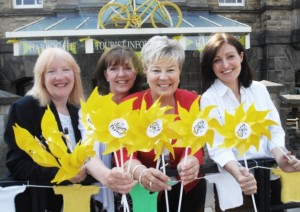Now we know where Harrogate is.
The first day of the 2014 Tour de France, which took palace in Yorkshire was an event of Olympic proportions, and enthusiasm. Was there ever a televised road journey with such massive, joyous support? The race started in Leeds and ended in the sedate spa town of Harrogate. The town’s promoters might have one regret. That they didn’t get quite as much coverage of the attractions as other places, because the emphasis was on the sprint finish. The Tour moved on, and, the hope is, the visitors move in. I was in Harrogate recently. This is my report.
Harrogate is one of the most elegant destinations in England, home to a famous tearoom, the newly restored Turkish Baths, a long list of stylish shops and restaurants, wide open parks and the Yorkshire Dales beckoning on its doorstep. The writer savours a northern gem: this is his list of things to do there.
Spa spree
Harrogate was the original detox centre. The perfect pre-breakfast treatment was three glasses of the sulphurous, foul-smelling water that comes coursing up from underground. There is no medical proof that it did anybody any good, but people seemed to get better even if it was only from following a strict regime of diet and exercise in this gracious town’s clean air. Today the Pump Room, no longer in use, displays interesting items and photographs from its prime, and, unexpectedly, an important collection of Ancient Egyptian artefacts. Today’s therapy is of the retail variety. Harrogate is a town for strolling elegantly between the many independent – some of them very exclusive – shops around Parliament St. The biggest concentration is in the Montpellier Quarter.
Top teas
You expect to queue at Betty’s. It’s part of the ritual. Go mid-afternoon for the best chance of a table at the window in one of the street-level rooms, rather than down in the basement. Since 1919 Betty’s has been a leader in the fine art of running a graceful, but never pompous, tearoom, meeting our urge to pause mid-afternoon, before scrumptious macaroons, vanilla slices, and their signature Fat Rascals on silver-plated three tier cake stands, with lemongrass and ginger tisane in shiny silver teapots. (Or whatever else takes your fancy here.) It’s expensive, with afternoon tea at £17.50, but you pay for impeccable service, with a blur of smart suited men and traditionally-attired waitresses busying about. Everything is cooked and prepared on the premises. www.bettys.co.uk
Melting moments
What could be a more appealing form of public (and utterly respectable) recreation on a cold, damp evening than Harrogate’s restored Turkish Baths? Built in 1899, they were renovated in 2004: another pleasing use of National Lottery funds. We went from the eucalyptus-infused sauna, and on through three rooms that are (roughly) hot, hotter and hotter still. The perspiring and freezing bit over, we lay back to admire the Islamic arches, glazed bricks and painted ceilings. They spare you the pummelling and pounding, the scraping and soaping on a marble slab, de rigeur in traditional Turkish baths. The toughest thing here is the plunge into the cold bath – smiling is obligatory, said the attendant. Stay as long as you like. Time is suspended as you glow.
Chip off Jamie’s block
We liked the small, thoughtful details: bottled tap water at the table (plain wood, no tablecloth) without asking, and free olives with our aperitifs. The owner and chef Christian Timberlake is Jamie Oliver’s age and shares his philosophy of a simple and straightforward restaurant, like a family-run place in France or Italy. His mother’s bold, bright paintings line the walls. The menu is as unfussy as the decor, with wood pigeon breast, guinea fowl, ewe’s cheese salad, and a succulent crème brûlée to finish the night we called. Let’s have more small places like this (Christian opened in 2011; his wife is the waitress) where the chef puts his reputation on the table. There were some excellent wines by the glass, and less well known bottled beers. www.timberlakesrestaurant.co.uk
Green fingers
Harlow Carr, set out in the 1880s on the edge of Harrogate, has become a very 21st-century garden. The Royal Horticultural Society took it over in 2000 and have transformed it. Strolls range from short and easy to a little bit longer: nothing is very far, from the Rose Revolution Borders and Annuals Meadows to the Rhododendron Glade and Alpine House. On our visit a helpful volunteer showed us wonderful photographs of the different colours of the trees in winter. The bird hide is worth a visit, for the fast moving feathers around the feeders. We saw great spotted woodpecker, bullfinches and coal tits. One section deals with the design of the garden from the C18th to today. Last stop is the garden’s very own branch of Betty’s tearoom, for well-nigh perfect coffee. www.rhs.org.uk/harlowcarr.
Victorian values
As the Industrial Revolution grew ever more grimy in nearby Leeds and Bradford, Harrogate emerged as a refined retreat, unsullied by smokestack. Visitors used to arrive for the spa in style by Pullman train. Today people throng here for conferences, which means there is a wide choice of good accommodation. We stayed at Ascot House, a 10 minute walk from the centre. This is one of the town’s many comfortable boutique hotels, built as an ample and solid Victorian town house for a big family. The original owner made his fortune with a machine that crushed stones into hardcore for roads. Surviving Victorian detail includes decorative plasterwork in the restaurant, staircase banisters and doors. The stained glass window over the staircase came from a demolished Victorian church. Over a hearty Yorkshire breakfast we contemplated views out to open countryside. www.ascothouse.com
For more information on Harrogate, go to www.harrogate.gov.uk

